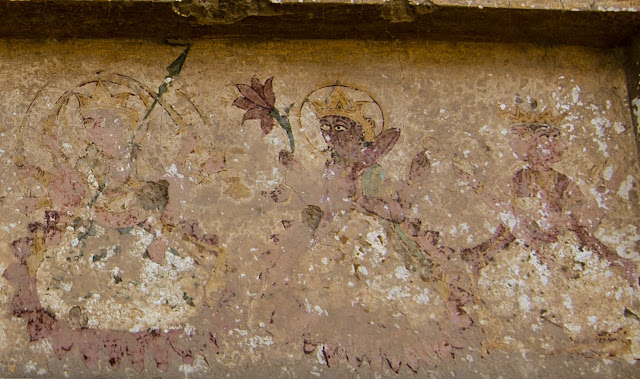Paintings at Udassi Shrine of Bhumman Shah
The Udasis do not reject the Sikh Gurus, but attach greater importance to the line of succession from Guru Nanak through Sri Chand to the Udasi mahants. They interpret the message of Guru Granth Sahib in Vedantic terms. They do not abide by the Khalsa's Rehat Maryada.The Udasis also worship the panchayatana, the five Hindu deities: Shiva, Vishnu, Durga, Ganesha, and Surya.
By the early 20th century, a number of Sikh gurdwaras in British India were under the control of the Udasi mahants (clergymen) or managers appointed by the Governors.
Udasi is a religious sect of ascetic sadhus centered in northern India. It is based on the teachings of Sri Chand (1494–1643), the son of Guru Nanak, the founder and the first Guru of Sikhism.
The word 'Udasi' is derived from the Sanskrit word which means "one who is indifferent to or disregardful of worldly attachments, a stoic, or a mendicant." In Sikh tradition, the term udasi has also been used for each of the four preaching tours of Guru Nanak Sahib Ji; in this sense, udasi meant a prolonged absence from home. Some scholars, including many Udasis, trace the origin of the sect back to the Puraṇic age, but, historically speaking, Baba Sri Chand was the founder.
In 1629, Sri Chand asked Guru Hargobind to spare one of his sons to join him in his religious preaching. The Guru gave him Baba Gurditta, his eldest son. Baba Gurditta, although married, was disposed to saintly living. Before his death, Baba Sri Chand admitted Baba Gurditta to the Udasi order and appointed him his successor. Baba Gurditta appointed four head preachers Almast, Phul, Goind (or Gonda) and Balu Husria. He gave them his own dress which became the peculiar Udasi garb and smouldering embers from Baba Sri Chand`s dhum (sadhu`s hearth) to be taken to their new monastic seats.
These Udasi sadhus set up from those embers a new dhuan each at his seat and thus came into existence the four dhunns or hearths which became the active centres of Udasi preaching. Each dhuari came to be known after the name of its principal preacher.
Baba Bhumman Shah, (also known as Baba Bhuman Shah, born Bhumia Hassa) is counted among the top Udasi saints of India. He was born on April 14, 1687 CE at Behlolpur village, Deepalpur Tehsil, Okara District, Punjab (Pakistan), in a family reportedly coming of Kamboj lineage. His father Chaudhury Hassa Ram was a Numbardar and a well-known landlord of Behlolpur. Hassa Ram and his wife Mata Rajo Bai were known to be deeply religious and devotees of Guru Nanak as well as of Baba Sri Chand, the founder of the Udasi Panth.
Baba Bhumman Shah travelled from village to village to preach his message of love, peaceful coexistence, universal brotherhood, religious-tolerance and equality. He had followers from many denominations including Hindus, Sikhs and Muslems.
Baba also visited the Dargah of Sufi Saint BabaFarid, Golden Temple at Amritsar, and numerous other Sikh and Hindu shrines during his religious itineraries. At village Kutub-Kot, which later became renowned as Dera Baba Bhumman Shah, Baba permanently established the maryada of Kirtan and free kitchen (Langar).
THANKS TO MR ALI USMAN BAIG
FOR THIS BEAUTIFUL ARTICLE
PLEASE VISIT THIS BOLG FOR MORE INFO
http://aliusmanbaig.blogspot.com/
























































No comments:
Post a Comment